Nickel–Iron-Layered Double Hydroxide Electrocatalyst with Nanosheets Array for High Performance of Water Splitting
Abstract
:1. Introduction
2. Results and Discussion
2.1. Characterization of the Electrocatalyst
2.2. Electronic States of NiFe3-LDH
2.3. Electrochemical Performance of NiFe-Based LDH
3. Materials and Methods
3.1. Materials
3.2. Electrocatalyst Preparation
3.3. Physical Characterization
3.4. Electrochemical Performance
4. Conclusions
Author Contributions
Funding
Institutional Review Board Statement
Informed Consent Statement
Data Availability Statement
Conflicts of Interest
References
- Fan, C.; Zhai, X.; Chen, L.; Peng, S.; Jiang, R.; Yu, J.; Li, Y.; Zhang, Y.; Kong, W.; Ge, G.; et al. Synthesis and electrocatalytic mechanism of ultrafine MFe2O4 (M: Co, Ni, and Zn) nanocrystallites: M/Fe synergistic effects on the electrochemical detection of Cu(ii) and hydrogen evolution reaction performances. J. Mater. Chem. A 2021, 9, 22277–22290. [Google Scholar] [CrossRef]
- Li, H.; Chen, L.; Jin, P.; Li, Y.; Pang, J.; Hou, J.; Peng, S.; Wang, G.; Shi, Y. NiCo2S4 microspheres grown on N, S co-doped reduced graphene oxide as an efficient bifunctional electrocatalyst for overall water splitting in alkaline and neutral pH. Nano Res. 2022, 15, 950–958. [Google Scholar] [CrossRef]
- Guan, D.Q.; Wang, B.W.; Zhang, J.G.; Shi, R.; Jiao, K.; Li, L.C.; Wang, Y.; Xie, B.; Zhang, Q.W.; Yu, J.; et al. Hydrogen society: From present to future. Energy Environ. Sci. 2023, 16, 4926–4943. [Google Scholar] [CrossRef]
- Liu, Y.; Yao, Q.; Wu, X.; Chen, T.; Ma, Y.; Ong, C.N.; Xie, J. Gold nanocluster sensitized TiO2 nanotube arrays for visible-light driven photoelectrocatalytic removal of antibiotic tetracycline. Nanoscale 2016, 8, 10145–10151. [Google Scholar] [CrossRef]
- Zhou, S.; Yue, P.; Huang, J.; Wang, L.; She, H.; Wang, Q. High-performance photoelectrochemical water splitting of BiVO4@Co-MIm prepared by a facile in-situ deposition method. Chem. Eng. J. 2019, 371, 885–892. [Google Scholar] [CrossRef]
- Cai, Q.; Liu, Z.; Han, C.; Tong, Z.; Ma, C. CuInS2/Sb2S3 heterostructure modified with noble metal co-catalyst for efficient photoelectrochemical water splitting. J. Alloys Compd. 2019, 795, 319–326. [Google Scholar] [CrossRef]
- Wang, D.; Chang, Y.-X.; Li, Y.-R.; Zhang, S.L.; Xu, S.L. Well-dispersed NiCoS2 nanoparticles/rGO composite with a large specific surface area as an oxygen evolution reaction electrocatalyst. Rare Metals 2021, 40, 3156–3165. [Google Scholar] [CrossRef]
- Cai, J.; Ding, J.; Wei, D.; Xie, X.; Li, B.; Lu, S.; Zhang, J.; Liu, Y.; Cai, Q.; Zang, S. Coupling of Ru and O-vacancy on 2D Mo-based electrocatalyst via a solid-phase interface reaction strategy for hydrogen evolution reaction. Adv. Energy Mater. 2021, 11, 2100141. [Google Scholar] [CrossRef]
- Dong, F.Y.; Zhang, M.H.; Xu, X.Y.; Pan, J.; Zhu, L.Y.; Hu, J.G. Orbital modulation with P doping improves acid and alkaline hydrogen evolution reaction of MoS2. Nanomaterials 2022, 12, 4273. [Google Scholar] [CrossRef]
- Zhang, L.; Yuan, H.; Li, X.; Wang, Y. Hydrothermal synthesis of NiCo2O4@NiCo2O4 core-shell nanostructures anchored on Ni foam for efficient oxygen evolution reactions catalysts. Coatings 2022, 12, 1240. [Google Scholar] [CrossRef]
- Yoon, S.J.; Lee, S.J.; Kim, M.H.; Park, H.A.; Kang, H.S.; Bae, S.Y.; Jeon, I.Y. Recent tendency on transition-metal phosphide electrocatalysts for the hydrogen evolution reaction in alkaline media. Nanomaterials 2023, 13, 2613. [Google Scholar] [CrossRef] [PubMed]
- Qiu, Y.; Feng, Z.; Ji, X.; Liu, J. Surface self-reconstruction of nickel foam triggered by hydrothermal corrosion for boosted water oxidation. Int. J. Hydrog. Energy 2021, 46, 1501–1508. [Google Scholar] [CrossRef]
- Liu, Z.; Zeng, L.; Yu, J.; Yang, L.; Zhang, J.; Zhang, X.; Han, F.; Zhao, L.; Li, X.; Liu, H.; et al. Charge redistribution of Ru nanoclusters on Co3O4 porous nanowire via the oxygen regulation for enhanced hydrogen evolution reaction. Nano Energy 2021, 85, 105940. [Google Scholar] [CrossRef]
- Yang, L.; Lin, Q.; Guo, D.Y.; Wu, L.H.; Guan, Z.X.; Jin, H.L.; Fang, G.Y.; Chen, X.A.; Wang, S. Nitrogen plasma activates CoMn-layered double hydroxides for superior electrochemical oxygen evolution. Inorg. Chem. 2023, 62, 17565–17574. [Google Scholar] [CrossRef] [PubMed]
- Huang, Z.F.; Song, J.J.; Du, Y.H.; Xi, S.B.; Dou, S.; Nsanzimana, J.M.V.; Wang, C.; Xu, Z.C.; Wang, X. Chemical and structural origin of lattice oxygen oxidation in Co-Zn oxyhydroxide oxygen evolution electrocatalysts. Nat. Energy 2019, 4, 329–338. [Google Scholar] [CrossRef]
- Li, A.; Chao, W.; Min, L.; Liu, H.W.; Chen, Y.B.; Scherer, G.G.; Fisher, A.C.; Xi, P.X.; Xu, Z.C.; Yan, C.H. Recent development of oxygen evolution electrocatalysts in acidic environment. Adv. Mater. 2021, 33, 2006328. [Google Scholar]
- Li, S.; Wang, L.; Li, Y.D.; Zhang, L.; Wang, A.; Xiao, N.; Gao, Y.; Li, N.; Song, W.; Ge, L.; et al. Novel photocatalyst incorporating Ni-Co layered double hydroxides with P-doped CdS for enhancing photocatalytic activity towards hydrogen evolution. Appl. Catal. B Environ. 2019, 254, 145–155. [Google Scholar] [CrossRef]
- Gu, K.Z.; Zhu, X.Y.; Wang, D.D.; Zhang, N.N.; Huang, G.; Li, W.; Long, P.; Tian, J.; Zou, Y.Q.; Wang, Y.Y.; et al. Ultrathin defective high-entropy layered double hydroxides for electrochemical water oxidation. J. Energy Chem. 2021, 60, 121–126. [Google Scholar] [CrossRef]
- He, D.Y.; Cao, L.Y.; Huang, J.F.; Kajiyoshi, K.J.; Wu, J.P.; Wang, C.C.; Liu, Q.Q.; Yang, D.; Feng, L.L. In-situ optimizing the valence configuration of vanadium sites in NiV-LDH nanosheet arrays for enhanced hydrogen evolution reaction. J. Energy Chem. 2020, 60, 121–126. [Google Scholar] [CrossRef]
- Feng, L.; Du, Y.; Huang, J.; Cao, L.; Feng, L.; Feng, Y.; Liu, Q.; Yang, D.; Kajiyoshi, K. Nanoporous NiAl-LDH nanosheet arrays with optimized Ni active sites for efficient electrocatalytic alkaline water splitting. Sustain. Energy Fuels 2020, 4, 2850–2858. [Google Scholar] [CrossRef]
- Liu, H.; Wang, Y.; Lu, X.; Hu, Y.; Zhu, G.; Chen, R.; Ma, L.; Zhu, H.; Tie, Z.; Liu, J.; et al. The effects of Al substitution and partial dissolution on ultrathin NiFeAl trinary layered double hydroxide nanosheets for oxygen evolution reaction in alkaline solution. Nano Energy 2017, 35, 350–357. [Google Scholar] [CrossRef]
- Ye, J.H.; Zhai, X.W.; Chen, L.; Guo, W.; Gu, T.T.; Shi, Y.L.; Hou, J.; Han, F.; Liu, Y.; Fan, C.C.; et al. Oxygen vacancies enriched nickel cobalt based nanoflower cathodes: Mechanism and application of the enhanced energy storage. J. Energy Chem. 2021, 62, 252–261. [Google Scholar] [CrossRef]
- Ye, C.; Zhang, L.; Yue, L.; Deng, B.; Cao, Y.; Liu, Q.; Luo, Y.; Lu, S.; Zheng, B.; Sun, X. A NiCo LDH nanosheet array on graphite felt: An efficient 3D electrocatalyst for the oxygen evolution reaction in alkaline media. Inorg. Chem. Front. 2021, 8, 3162–3166. [Google Scholar] [CrossRef]
- Wang, J.; Tan, C.F.; Zhu, T.; Ho, G.W. Topotactic consolidation of monocrystalline CoZn hydroxides for advanced oxygen evolution electrodes. Angew. Chem. Int. Ed. 2016, 55, 10326–10330. [Google Scholar]
- Zhang, S.C.; Liu, Z.F.; Chen, D.; Guo, Z.G.; Ruan, M.N. Oxygen vacancies engineering in TiO2 homojunction/ZnFe-LDH for enhanced photoelectrochemical water oxidation. Chem. Eng. J. 2020, 395, 125101. [Google Scholar] [CrossRef]
- Wang, F.Q.; Zou, P.C.; Zhang, Y.Y.; Pan, W.L.; Li, Y.; Liang, L.M.; Chen, C.; Liu, H.; Zheng, S.J. Activating lattice oxygen in high-entropy LDH for robust and durable water oxidation. Nat. Commun. 2023, 14, 6019. [Google Scholar] [CrossRef]
- Guo, F.; Wu, Y.; Chen, H.; Liu, Y.; Yang, L.; Ai, X.; Zou, X. High-performance oxygen evolution electrocatalysis by boronized metal sheets with self-functionalized surfaces. Energy Environ. Sci. 2019, 12, 684–692. [Google Scholar] [CrossRef]
- Zhang, L.; Lu, C.; Ye, F.; Pang, R.; Liu, Y.; Wu, Z.; Shao, Z.; Sun, Z.; Hu, L. Selenic acid etching assisted vacancy engineering for designing highly active electrocatalysts toward the oxygen evolution reaction. Adv. Mater. 2021, 33, e2007523. [Google Scholar] [CrossRef]
- Zhong, W.; Wang, Z.; Gao, N.; Huang, L.; Lin, Z.; Liu, Y.; Meng, F.; Deng, J.; Jin, S.; Zhang, Q.; et al. Coupled vacancy pairs in Ni-doped CoSe for improved electrocatalytic hydrogen production through topochemical deintercalation. Angew. Chem. 2020, 59, 22743–22748. [Google Scholar] [CrossRef]
- Wurster, B.; Grumelli, D.; Hotger, D.; Gutzler, R.; Kern, K. Driving the oxygen evolution reaction by nonlinear cooperativity in bimetallic coordination catalysts. J. Am. Chem. Soc. 2016, 138, 3623–3626. [Google Scholar] [CrossRef]
- Xue, Y.; Ren, Z.; Xie, Y.; Du, S.; Wu, J.; Meng, H.; Fu, H. CoSex Nanocrystalline-dotted CoCo layered double hydroxide nanosheets: A synergetic engineering for enhanced electrocatalytic water oxidation. Nanoscale 2017, 8, 10827–10835. [Google Scholar]
- Wu, X.; Han, S.; He, D.; Yu, C.; Lei, C.; Liu, W.; Zheng, G.; Zhang, X.; Lei, L. Metal organic framework derived Fe-doped CoSe2 incorporated in nitrogen-doped carbon hybrid for efficient hydrogen evolution. ACS Sustain. Chem. Eng. 2018, 6, 8672–8678. [Google Scholar] [CrossRef]
- Cai, T.; Zhao, L.; Hu, H.; Li, T.; Li, X.; Guo, S.; Li, Y.; Xue, Q.; Xing, W.; Yan, Z.; et al. Stable CoSe2/carbon nanodice@reduced graphene oxide composites for high-performance rechargeable aluminum-ion batteries. Energy Environ. Sci. 2018, 11, 2341–2347. [Google Scholar] [CrossRef]
- Xia, X.F.; Lei, W.; Hao, Q.L.; Wang, W.J.; Wang, X. One-step synthesis of CoMoO4/graphene composites with enhanced electrochemical properties for supercapacitors. Electrochim. Acta 2013, 99, 253–261. [Google Scholar] [CrossRef]
- Guan, D.Q.; Shi, C.L.; Xu, H.Y.; Gu, Y.X.; Zhong, J.; Sha, Y.C.; Hu, Z.W.; Ni, M.; Shao, Z.P. Simultaneously mastering operando strain and reconstruction effects via phase-segregation strategy for enhanced oxygen-evolving electrocatalysis. J. Energy Chem. 2023, 82, 572–580. [Google Scholar] [CrossRef]
- Friebel, D.; Louie, M.W.; Bajdich, M.; Sanwald, K.E.; Cai, Y.; Wise, A.M.; Cheng, M.-J.; Sokaras, D.; Weng, T.C.; Alonso, R. Identification of highly active Fe sites in (Ni, Fe) OOH for electrocatalytic water splitting. J. Am. Chem. Soc. 2015, 137, 1305–1313. [Google Scholar] [CrossRef]
- Sun, H.; Li, L.; Chen, Y.; Kim, H.; Xu, X.; Guan, D.; Hu, Z.; Zhang, L.; Shao, Z.; Jung, W.C. Boosting ethanol oxidation by NiOOH-CuO nano-heterostructure for energy-saving hydrogen production and biomass upgrading. Appl. Catal. B Environ. 2023, 325, 122388. [Google Scholar] [CrossRef]
- Lv, J.; Wang, L.; Li, R.; Zhang, K.; Zhao, D.; Li, Y.; Li, X.; Huang, X.; Wang, G. Constructing a hetero-interface composed of oxygen vacancy-enriched Co3O4 and crystalline–amorphous NiFe-LDH for oxygen evolution reaction. ACS Catal. 2021, 11, 14338–14351. [Google Scholar] [CrossRef]
- Sun, H.; Xu, X.; Kim, H.; Jung, W.; Zhou, W.; Shao, Z. Electrochemical water splitting: Bridging the gaps between fundamental research and industrial applications. Energy Environ. Mater. 2022, 6, e12441. [Google Scholar] [CrossRef]
- Baz, A.; Holewinski, A. Predicting macro-kinetic observables in electrocatalysis using the generalized degree of rate control. J. Catal. 2021, 397, 233–244. [Google Scholar] [CrossRef]
- Jin, H.; Mao, S.; Zhan, G.; Xu, F.; Bao, X.; Wang, Y. Fe incorporated α-Co (OH)2 nanosheet with remarkably improved activity towards oxygen evolution reaction. J. Mater. Chem. A 2017, 7, 11035–11042. [Google Scholar]
- Wang, Z.; Liu, W.; Hu, Y.; Xu, L.; Guan, M.; Qiu, J.; Huang, Y.; Bao, J.; Li, H. Fe-doped NiV LDH ultrathin nanosheet as a highly efficient electrocatalyst for efficient water oxidation. Inorg. Chem. Front. 2019, 3, 1361–1368. [Google Scholar] [CrossRef]
- Zhu, X.; Tang, C.; Wang, H.; Li, B.; Zhang, Q.; Li, C.; Yang, C.; Wei, F. Monolithic-structured ternary hydroxides as freestanding bifunctional electrocatalysts for overall water splitting. J. Mater. Chem. A 2016, 4, 6164–6172. [Google Scholar] [CrossRef]
- Louie, M.W.; Bell, A.T. An Investigation of Thin-Film Ni-Fe Oxide Catalysts for the Electrochemical Evolution of Oxygen. J. Am. Chem. Soc. 2013, 135, 12329–12337. [Google Scholar] [CrossRef] [PubMed]
- Li, Z.Y.; Zhang, Y.; Liu, Z.S.; Sun, H.B.; Shi, Z.N.; Xu, J.L. Enhanced electrocatalytic performance of NiFe layered double hydroxide for oxygen evolution reaction by CoW surface codoping. Int. J. Hydrogen Energy 2024, 51, 895–903. [Google Scholar] [CrossRef]
- Gui, Y.; Liu, X.; Dou, Y.; Zhang, L.; Al-Mamun, M.; Jiang, L.; Yin, H.; He, C.-T.; Zhao, H. Manipulating the assembled structure of atomically thin CoSe2 nanomaterials for enhanced water oxidation catalysis. Nano Energy 2019, 57, 371–378. [Google Scholar] [CrossRef]

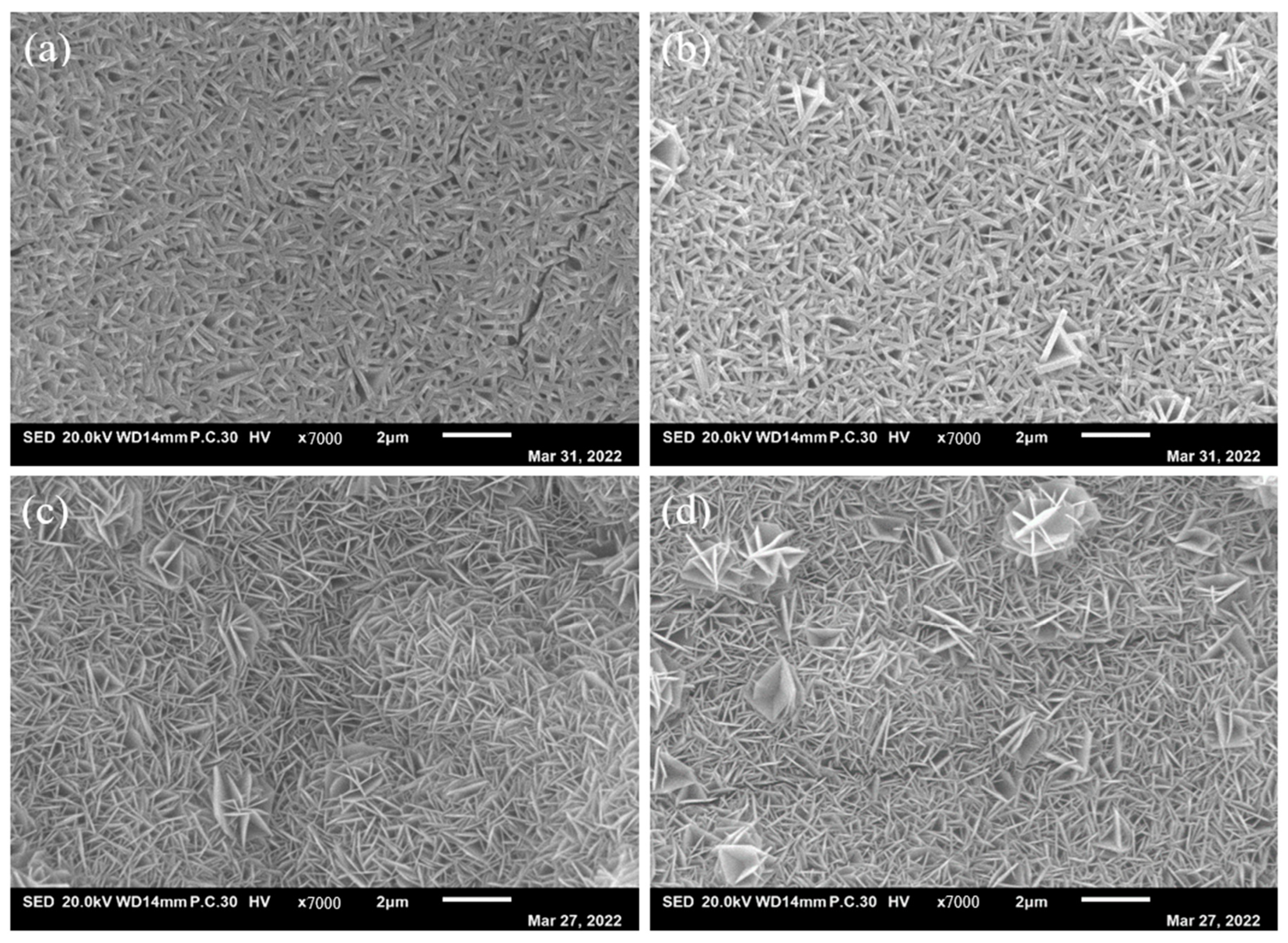
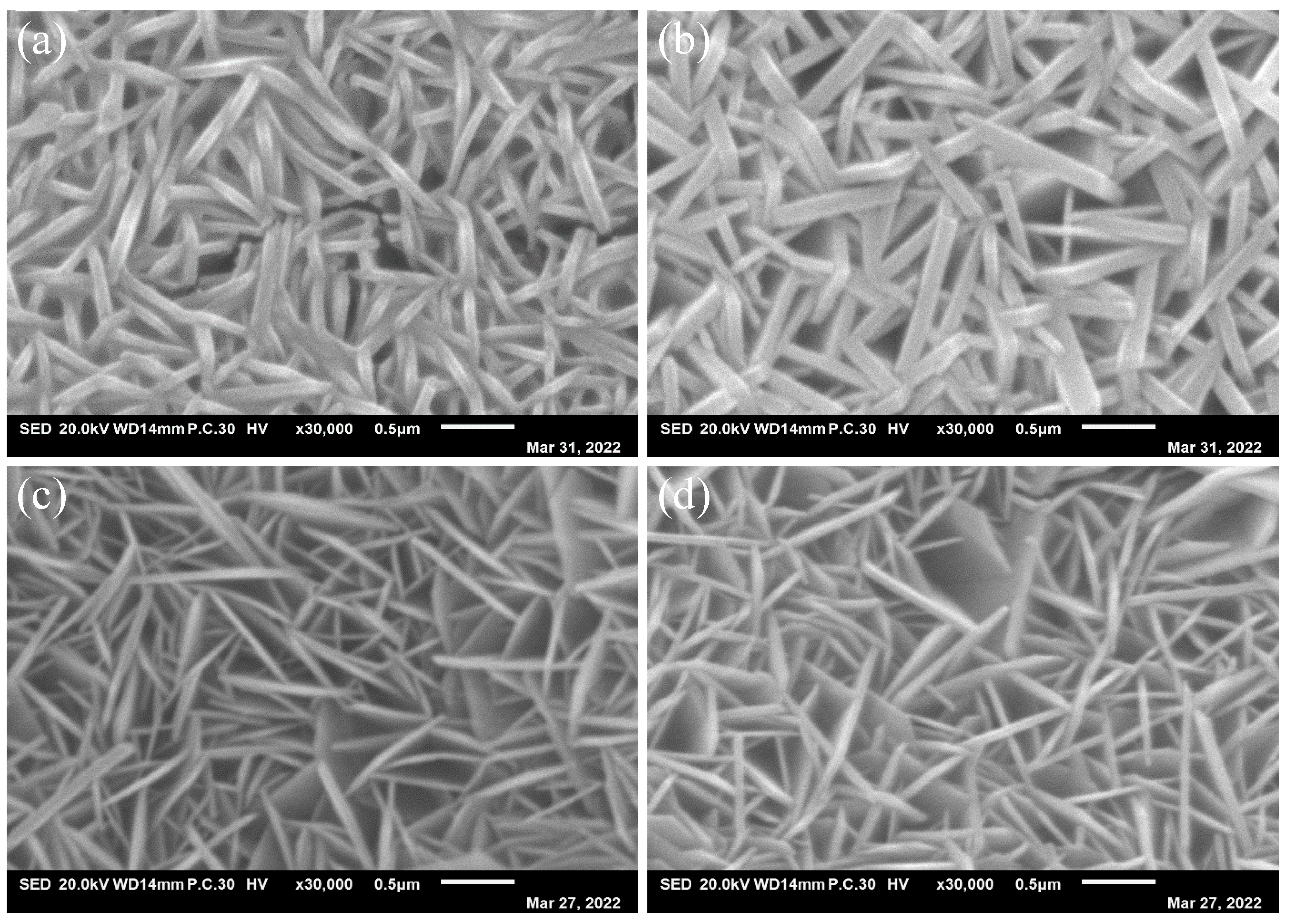



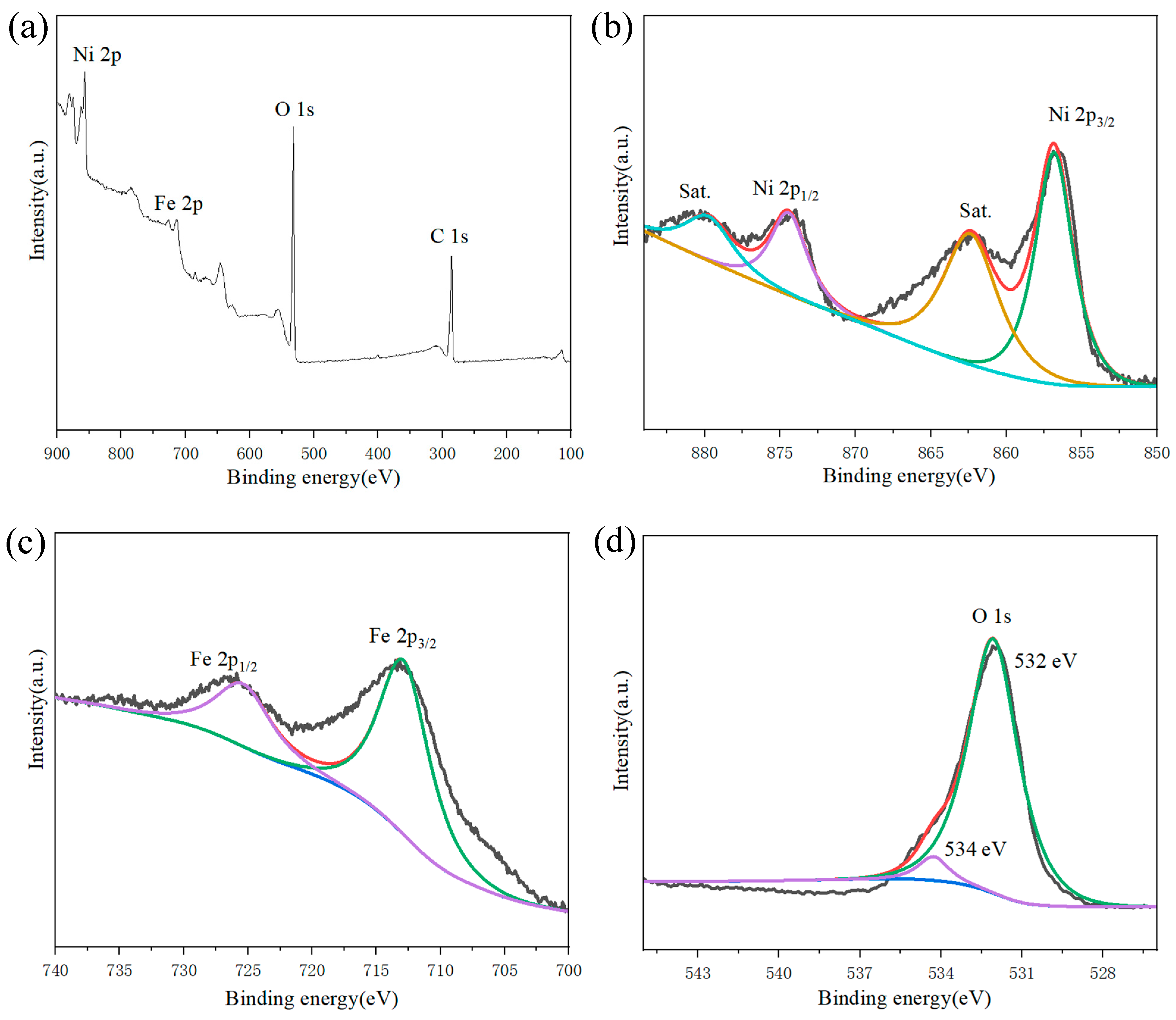
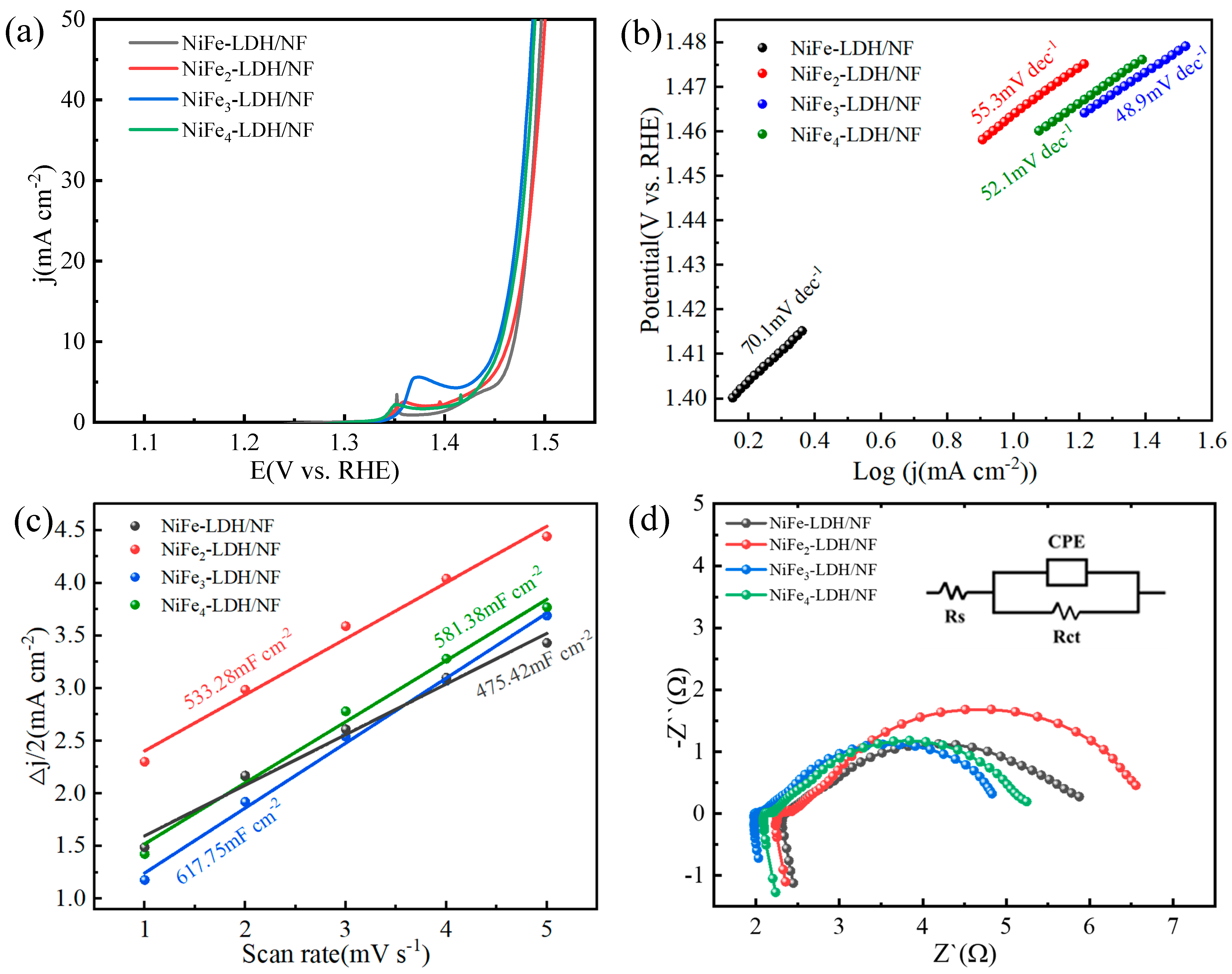
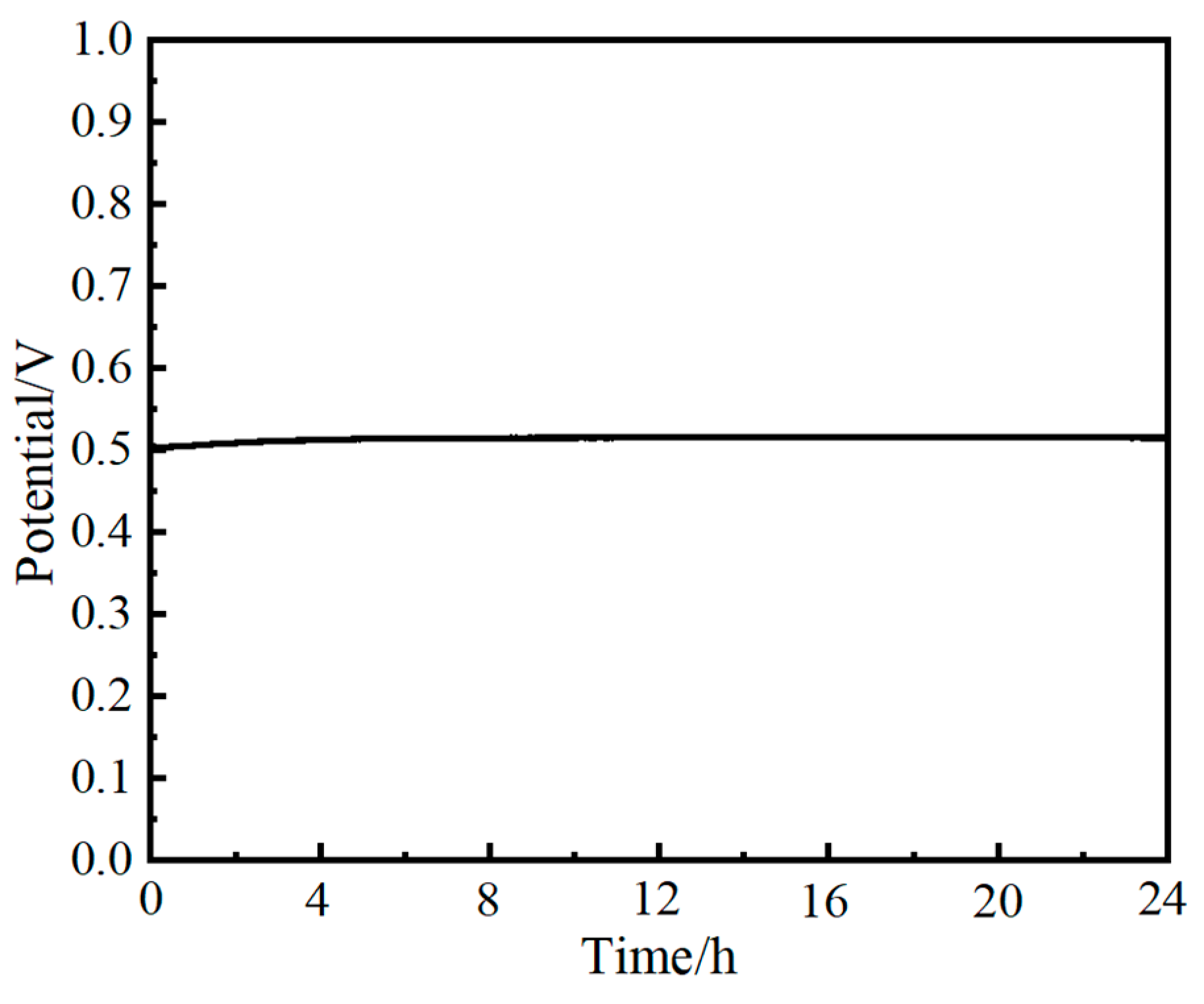
| Products | Length (µm) | Thickness (nm) | Ratio of L/T |
|---|---|---|---|
| NiFe-LDH | 0.72 | 84 | 8.57 |
| NiFe2-LDH | 1.083 | 107 | 10.12 |
| NiFe3-LDH | 0.934 | 69 | 13.54 |
| NiFe4-LDH | 0.846 | 73 | 11.59 |
Disclaimer/Publisher’s Note: The statements, opinions and data contained in all publications are solely those of the individual author(s) and contributor(s) and not of MDPI and/or the editor(s). MDPI and/or the editor(s) disclaim responsibility for any injury to people or property resulting from any ideas, methods, instructions or products referred to in the content. |
© 2024 by the authors. Licensee MDPI, Basel, Switzerland. This article is an open access article distributed under the terms and conditions of the Creative Commons Attribution (CC BY) license (https://creativecommons.org/licenses/by/4.0/).
Share and Cite
Lu, Z.; Li, S.; Ning, L.; Tang, K.; Guo, Y.; You, L.; Chen, C.; Wang, G. Nickel–Iron-Layered Double Hydroxide Electrocatalyst with Nanosheets Array for High Performance of Water Splitting. Molecules 2024, 29, 2092. https://doi.org/10.3390/molecules29092092
Lu Z, Li S, Ning L, Tang K, Guo Y, You L, Chen C, Wang G. Nickel–Iron-Layered Double Hydroxide Electrocatalyst with Nanosheets Array for High Performance of Water Splitting. Molecules. 2024; 29(9):2092. https://doi.org/10.3390/molecules29092092
Chicago/Turabian StyleLu, Zhi, Shilin Li, Laiyuan Ning, Kun Tang, Yifan Guo, Long You, Chong Chen, and Guangxin Wang. 2024. "Nickel–Iron-Layered Double Hydroxide Electrocatalyst with Nanosheets Array for High Performance of Water Splitting" Molecules 29, no. 9: 2092. https://doi.org/10.3390/molecules29092092
APA StyleLu, Z., Li, S., Ning, L., Tang, K., Guo, Y., You, L., Chen, C., & Wang, G. (2024). Nickel–Iron-Layered Double Hydroxide Electrocatalyst with Nanosheets Array for High Performance of Water Splitting. Molecules, 29(9), 2092. https://doi.org/10.3390/molecules29092092





